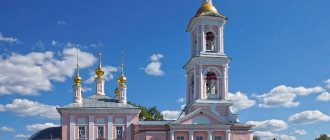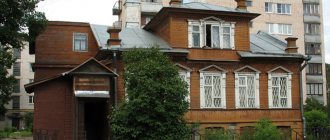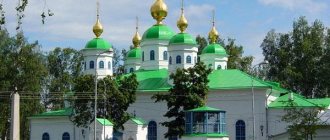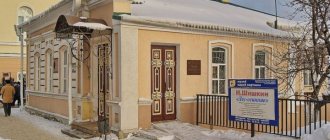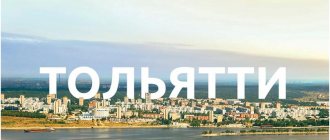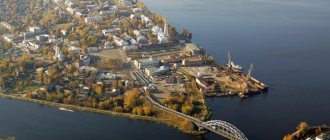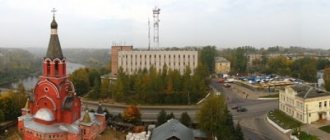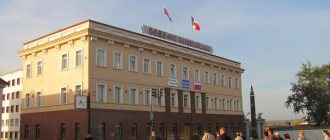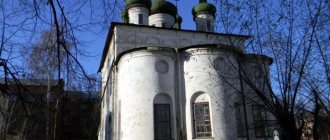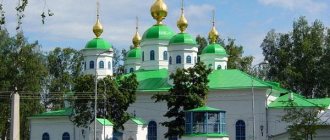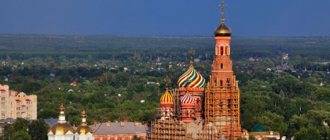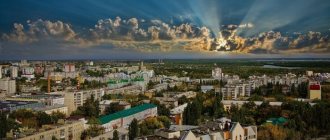Museum of History and Local Lore
Among the attractions of Mozhga, it is worth paying attention to the Museum of Local Lore, which houses rich collections related to such sciences as ethnography, paleontology, archeology and history. It is the cultural center of the city. It hosts scientific and historical events.
The museum had to go a long way to achieve such a high status. It was opened in 1936, and in 1941 it was closed because all funds were lost. It was reopened only in 1979. The museum exhibited works by local artists. Scientists, with the help of local guards, gradually collected a lot of information about the history of the region. The establishment received its current status in 2011.
Map
| Mozhga: maps |
Mozhga: photo from space (Google Maps) Mozhga: photo from space (Microsoft Virtual Earth)
| Mozhga. Nearest cities. Distances in km. on the map (in brackets along roads) + direction. Using the hyperlink in the distance , you can get the route (information courtesy of the AutoTransInfo website) | |||
| 1 | Alnashi | 33 (38) | SE |
| 2 | Vavozh | 39 (46) | NW |
| 3 | Kizner | 46 (78) | SW |
| 4 | Grahovo | 47 (77) | YU |
| 5 | Agryz | 48 (58) | IN |
| 6 | Malaya Purga | 49 (62) | IN |
| 7 | Kiyasovo | 56 (102) | IN |
| 8 | Uva | 59 (78) | WITH |
| 9 | Sosnovka | 61 (245) | Z |
| 10 | Mendeleevsk | 61 (76) | YU |
| 11 | Krasnaya Polyana (Kirov region) | 70 (237) | Z |
| 12 | Vyatskiye Polyany | 75 (230) | Z |
| 13 | Izhevsk | 75 (87) | NE |
| 14 | Elabuga | 76 (98) | YU |
| 15 | Naberezhnye Chelny | 79 (111) | YU |
| 16 | Zavyalovo | 80 (101) | NE |
| 17 | Syumsi | 81 (147) | NW |
| 18 | Hohryaks | 84 () | NE |
| 19 | Kukmor | 86 (217) | Z |
| 20 | Kilmez (Kirov region) | 88 (188) | NW |
| 21 | Nizhnekamsk | 94 (155) | YU |
| 22 | Selty | 95 (118) | WITH |
| 23 | Sigaevo | 95 (131) | IN |
| 24 | Malmyzh | 95 (287) | Z |
| 25 | Sarapul | 97 (124) | IN |
| 26 | Mamadysh | 97 (157) | SW |
| 27 | Menzelinsk | 98 (168) | SE |
| 28 | Yakshur-Bodya | 99 (132) | NE |
| 29 | Karakulino | 104 (180) | SE |
| 30 | Shemordan (Republic of Tatarstan) | 116 (276) | Z |
a brief description of
The city is located in the Kama region, on the river. Syuginka, 97 km southwest of Izhevsk. Railway station.
Territory (sq. km): 31
Information about the city of Mozhga on the Russian Wikipedia site
Historical sketch
Founded in 1835 as a settlement at the Syuginsky glass factory (it was famous for the production of technical glass, jugs, and animal figurines). Name of the plant by location on the river. From South.
After 1917, the village of Sovetsky, later the village of Krasny. The city of Mozhga since 1926. The first name was simply an ideological cliche, and the modern one is associated with the name of one of the largest clan associations of the Udmurts, which lived in these places.
Municipal indicators
| Index | 2001 |
| Demography | |
| Number of births, per 1000 population | 10.5 |
| Number of deaths, per 1000 population | 15.2 |
| Natural increase (decrease), per 1000 population | -4.7 |
| Standard of living of the population and social sphere | |
| Average monthly nominal accrued wages, rub. | 2451.6 |
| Average housing area per inhabitant (at the end of the year), sq.m. | 16.9 |
| Number of preschool institutions, pcs. | 20 |
| Number of children in preschool institutions, thousand people | 2.4 |
| Number of daytime educational institutions (at the beginning of the school year), pcs. | 10 |
| Number of students in daytime educational institutions, thousand people | 7.1 |
| Number of doctors, people. | 218 |
| Number of nursing staff, people. | 795 |
| Number of hospital institutions, pcs. | 6 |
| Number of hospital beds, thousand units | 0.7 |
| Number of medical outpatient clinics, pcs. | 6 |
| Capacity of medical outpatient clinics, visits per shift, thousand units. | 1.7 |
| Number of registered crimes, pcs. | 604 |
| Persons who committed crimes were identified, persons. | 797 |
| Economy, industry | |
| Number of enterprises and organizations (at the end of the year), pcs. | 437 |
| Construction | |
| Volume of work performed by type of activity “Construction” (until 2004 - volume of work performed under construction contracts), million rubles. | 220.3 |
| Commissioning of residential buildings, thousand sq.m. of total area | 4.6 |
| Commissioning of residential buildings, apartments | 40 |
| Commissioning of preschool institutions, places | 0 |
| Commissioning of educational institutions, places | 825 |
| Commissioning of hospital facilities, beds | 0 |
| Commissioning of outpatient clinics, visits per shift | 0 |
| Transport | |
| Number of bus routes (in intracity traffic), pcs. | 7 |
| Number of passengers transported by buses per year (in intracity traffic), million people. | 9.2 |
| Connection | |
| Number of residential telephone sets of the city public telephone network, thousand units. | 6.5 |
| Trade and services to the population | |
| Retail trade turnover (in actual prices), million rubles. | 782.8 |
| Retail trade turnover (in actual prices), per capita, rub. | 15910 |
| Public catering turnover (in actual prices), million rubles. | 18.2 |
| Volume of paid services to the population (in actual prices), million rubles. | 112.4 |
| Volume of paid services to the population (in actual prices), per capita, rub. | 2284 |
| Volume of household services to the population (in actual prices), million rubles. | 21.2 |
| Volume of household services to the population (in actual prices), per capita, rub. | 431 |
| Investments | |
| Investments in fixed assets (in actual prices), million rubles. | 150.3 |
| Share of investments in fixed assets financed from budgetary funds in the total volume of investments, % | 8 |
Data sources:
- Regions of Russia. Main characteristics of the constituent entities of the Russian Federation: statistical collection. Goskomstat of Russia. - M:, 2003.
Economy
Mozhga is a significant industrial center in the southwestern part of Udmurtia.
Leading enterprises: JSC - "Dubitel" (production of tanning extract), "Svet" (glass and polyethylene products), "Mozhginsky Electric Capacitor", "Fason" (sewing), "Konus" (gearboxes, cast iron), "Avtoremzavod" ", "Mozhginsky Timber Plant".
Food industry enterprises. Production of school writing supplies, children's toys, etc.
Main enterprises
MECHANICAL ENGINEERING
OJSC "Konus"
427760, Udmurt Republic, Mozhga, Syugailsky Ave., 15
Offers:
FORESTRY, WOOD PROCESSING AND PULP AND PAPER INDUSTRY
JSC "TIR Krasnaya Zvezda"
, Udmurt Republic, Mozhga, st.
Gorbunova, 32 Offers:
School stationery, furniture
OJSC "Mozhginsky L/K"
, Udmurt Republic, Mozhga, st.
Bayborodova, 52 Offers:
Furniture
GLASS AND PORCELAIN AND FAIENCE INDUSTRY
OJSC "Svet"
427792, Udmurt Republic, Mozhga, Sverdlovsky Blvd., 39
Offers:
glass containers, plastic products, polyethylene film
LIGHT INDUSTRY
JSC "Fason"
427760, Udmurt Republic, Mozhga, st.
Nagovitsyna, 13 Offers:
BUTTER CHEESE AND DAIRY INDUSTRY
OJSC "Mozhga-Syr"
427600, Udmurt Republic, Mozhga, st.
Zheleznodorozhnaya, 107 Offers:
Hard cheese, whole milk products
Universities of the city
Udmurt State University (Mozhga branch)
427790, Udmurt Republic, Mozhga, st. International, 88
Museums, galleries, exhibition halls
Mozhga Museum of History and Local Lore 427790, Udmurt Republic, Mozhga, st.
Ustyuzhanina, 11 Telephone(s): (34139) 4-12-20 National Museum “Alarm of Memory” 427790, Udmurt Republic, Mozhga, st. Nagovitsyna, 46-a Phone(s): (34139) 3-18-48
Architecture, sights
The building of the teachers' seminary (1929, now a pedagogical college) has been preserved.
| Population by year (thousands of inhabitants) | |||||||
| 1926 | 2.4 | 1992 | 48.2 | 2007 | 49.0 | 2016 | 49.7 |
| 1931 | 7.7 | 1996 | 48.4 | 2008 | 49.4 | 2017 | 49.6 |
| 1939 | 22.2 | 1998 | 48.3 | 2010 | 50.1 | 2018 | 49.3 |
| 1959 | 30.0 | 2000 | 48.8 | 2011 | 48.0 | 2019 | 49.1 |
| 1967 | 32 | 2001 | 49.0 | 2012 | 48.8 | 2020 | 49.0 |
| 1970 | 38.9 | 2003 | 47.1 | 2013 | 49.3 | 2021 | 48.8 |
| 1979 | 40.3 | 2005 | 47.8 | 2014 | 49.8 | ||
| 1989 | 46.0 | 2006 | 48.4 | 2015 | 49.8 | ||
Alarm of memory
Another attraction of Mozhga is the Alarm of Memory Museum. It was opened within the walls of school No. 2. Initially, the institution was called “Buchenwald Alarm”, since its exhibition consisted of materials dedicated to the history of the Nazi concentration camp. The museum was considered a school museum, but since 1983 it turned into a folk museum of the Udmurt Republic, and later it became municipal.
Currently, its walls provide not only information about Buchenwald, but also information about local residents who took an active part in the Great Patriotic War, about military formations, about besieged Leningrad and famous pilots. Within the walls of the museum there is a club “Frontline Friends”, which once included 42 people. But at present there is only one front-line soldier left.
Mozhga
Historical reference
The emergence of the city of Mozhga is associated with the construction of a glass factory in 1835 and the first settlements of people who worked in this production.
This is mentioned in the calendar of the Vyatka province of 1887. By this time, there were already over 200 glass factories in Russia. The Syuginsky glass factory was the first in Udmurtia that has survived to this day. The founder of the plant is Honorary Citizen of Elabuga, merchant of the 1st guild F.G. Chernov. In 1842, the new owner, the Ural industrialist A.E. Lebedev, began improving glass production and expanding it. He resettled here 25 families of assigned glass workers from enterprises he owned in the Nizhny Novgorod and Kazan Vyatka provinces. Master glassblowers were famous for the art of producing both technical and household glass. In 1892, the main products of the plant were window plate glass, beer bottles and acid storage containers. The products of the Syuginsky plant successfully competed in sales markets throughout Russia. Along with the plant, the village was also being developed. By 1914, the village had 1,367 residents, 68 residential buildings, a stone church (1901), a hospital with 3 beds, a pharmacy, a library-reading room, and temporary premises for a theater, which hosted 5-10 performances a year.
The Kazan-Ekaterinburg railway, built in 1915, was of great importance for the development of the plant and the village.
The bulk of food and industrial goods were purchased from trading companies in Elabuga, Kazan, and at the Nizhny Novgorod Fair.
The village consisted of three streets, called “orders”. The central street of the village was called Big Order (now Oktyabrskaya Street). Today it has retained its layout. XX century.
In 1924 - 1925, active construction of residential buildings and buildings began in the village according to the technical plan of the first architect of the city of Mozhga, Stepan Efremovich Pustoshintsev. One of the streets of our city bears his name. The village was a continuous construction site.
The village was given city status in 1926 according to the resolution of the Presidium of the Central Executive Committee dated October 4, 1926.
Since the early 1920s, cottage industry has become widespread. During these years, the city produced technical and household glass, lumber, furniture, brick, cooperage, soap, carpenter's glue, fir oil and resin, wheel ointment, turpentine, student supplies, and children's toys.
In May 1932, a tanning-extract plant, later the “Tanner”, was put into operation. Included in the title are 518 large domestic construction projects of the 1st Five-Year Plan. Its opening marked the creation of a new domestic enterprise for the production of tanning extract for the leather industry. This brought the country annual savings of hundreds of thousands of rubles in foreign currency.
Since the mid-1930s, Mozhga was the second industrial center of Udmurtia after Izhevsk. There were 3 technical schools (pedagogical, medical and veterinary), a regional collective farm school, and 5 secondary schools.
The city withstood the difficult trials during the Great Patriotic War with honor. All enterprises in the city switched to producing military products: cast iron cases for F-1 hand grenades, handles for infantry shovels, sleds, skis, ski poles, sheepskin coats, and tunics. Several plants and factories were evacuated to the city, as well as the 2nd Moscow Machine Gun School.
The city received the evacuated population. To treat wounded and sick front-line soldiers, 3 hospitals and a special hospital for foreign prisoners of war operated in the city. Residents of the city contributed money for war loans, showed concern for the soldiers of the Red Army, and collected food, warm clothes, and gifts.
In the 2nd half of the 1940s-1950s. Mozhga enterprises, having overcome the severe consequences of the war, entered a normal production rhythm.
In the 1960-1980s, industry actively developed, new products appeared at enterprises: products made of polymer materials. Some of the glass factory's products have received high recognition at national and international exhibitions. The Krasnaya Zvezda factory, a foundry and mechanical plant, begins to produce new products.
Saburov Museum
The Saburov Museum is another attraction of Mozhga. The institution was opened in 1966 on the initiative of a local teacher of Russian literature and language, Chizhova, who, together with her students, decided to collect materials about the defenders of the Brest Fortress. To do this, the children had to find the addresses of the heroes in the passport office and correspond with them. This is how information was collected that formed the basis of the exhibition.
The museum also contains information about the children and women of Udmurtia who were awarded the title of Hero of the Soviet Union. In 1981, the institution was given the status of a People's Museum.
City of Mozhga (Udmurtia)
The city of Mozhga is located in the southwestern part of Udmurtia on the Mozhginskaya Upland, in the valley of the non-navigable and non-raftable Syuginka River (a tributary of the Vala), on the Kazan - now Yekaterinburg railway. Mozhga is surrounded by forests from the north, south and west.
The city was founded in 1825 as a settlement at the Syuginsky glass factory, a famous manufacturer of glass, jugs and animal figurines. The name of the plant based on its location on the Syuga River. After 1917, the village of Sovetsky, later the village of Krasny. Mozhga has been a city since 1926.
The first name was an ideological stamp; modern - associated with the name of one of the largest clan associations of the Udmurts, which lived in these places. Mozhga is a significant industrial center in the southwestern part of Udmurtia.
The most developed industries are glass, food, wood processing and forestry. Main attractions: Museum of History and Local Lore, Museum "Alarm of Memory", Ethnographic Museum "Udmurt Folk Art", People's Museum of Heroes of the Soviet Union - Defenders of the Brest Fortress and Saburov partisans, Temple of the Archangel Michael (the first brick building of the city), Museum, first street of the village Oktyabrskaya, , .
In terms of population, the city is of medium size: in the Udmurt Republic it is inferior to Izhevsk, Sarapul, Votkinsk, Glazov, leaving behind only Kambarka. From the capital of Udmurtia to Mozhga there are 93 kilometers by rail. Other nearby cities are Vyatskie Polyany (90 km), Sarapul (116), Glazov (297), Kazan (233), Perm (442), Kirov (405 km). Moscow is 1036 kilometers away.
Mozhga is connected to the country's heavy transport route. This indicates the advantageous geographical location of the city, as well as the opportunity for broad economic, cultural and other ties with the whole country. Paved roads connect Mozhga with Izhevsk, Elabuga, Naberezhnye Chelny, and other cities and towns. For the southwestern part of Udmurtia, Mozhga is the most important economic and cultural center.
Information from the Great Soviet Encyclopedia (vol. 16, p. 412, 1974): “Mozhga is a city of republican (ASSR) subordination in the Udmurt ASSR. Railway station on the Kazan-Agryz line. 38.9 thousand inhabitants (1970). It grew during the years of Soviet power from a small village that arose in the middle of the 19th century (the city - since 1926). Glass, tanning-extract and machine-building factories, sawmill and furniture plant. Veterinary College, Medical and Pedagogical Schools.”
Where did the name itself come from - Mozhga?
For clarification, let us turn to the article by S. Masalova, a researcher at the Mozhginsky Museum of Local Lore, “Where did our name come from” (“Mozhginskiye Vesti.” 1999, June 10).
“A long time ago, when the tribal system still existed, one of the tribes of the southern Udmurts settled in the lower reaches of the Vala River. The leader of this tribe was Mardan Batyr. The descendants of Mardan and his tribe year after year conquered new lands from the dense forest. This is how settlements (villages) arose.
One of Mardan’s sons, Mozhga, in search of fertile lands, reached the Nysha River, stayed to live here and laid the foundation for the village named after him. It is assumed that on the site of the village of Mozhgi there was a camp of Kama Bulgars before the Udmurts.
From the middle of the 18th century Mozhga
began to be settled by Russians, the Christianization of the Udmurt people began. For this reason, many left the village and formed new villages. This is how Udmurt Syugail, Upper and Lower Vishur, Chebershur, Chumoitlo, Chezhest, and Kinyagil appeared. At the same time, purely Russian villages grew: Cherny Log, Bikbai, Izhnyuk and others. In 1787, a stone church began to be built in Mozhga. It was consecrated during the Patriotic War of 1812.
In 1843, a parish school was opened in the village.
The village was densely populated
there were many two-story houses. The population was engaged in agriculture and cattle breeding. Crafts were well developed: blacksmithing, leather dressing, extraction of resin and tar, they made bast and matting for sale.
In the 19th century, Mozhga was a large trading village.
There were over a dozen shops here, crowded markets gathered on Sundays, and fairs were held twice a year. The people lived very frugally. We tried to do without buying industrial goods.
On May 8, 1924, the village was almost completely burned due to a fire.
The construction of the district center began near the Syuginsky glass factory. And the village was gradually rebuilt and is still thriving on the beautiful banks of the Nysha.”
Based on the book
Vichuzhanin A.G. Mozhga. Town above the Syuginka River
/ A.G. Vichuzhanin. – Izhevsk: Udmurtia, 2001.
The book tells about the history of the emergence and development of Mozhga. The author of the book is Honored Worker of Public Education of the Ural Republic A.G. Vichuzhanin talks about people who left their mark on the history of the city, industrial and social facilities, public education, culture, and healthcare.
Monument "Airplane"
Among the attractions of Mozhga (photos of some of them are given in the article) is the “Airplane” monument, erected in August 2014 in honor of the 115th anniversary of the hero of the Great Patriotic War F. Ya. Faleev, an air marshal originally from Mozhga.
The monument was installed on the street of the same name and is a boom with an L-29 training aircraft mounted on it.
Memorial to WWII soldiers
The memorial is a significant landmark of the city of Mozhga. It was installed after the reburial of the soldiers' bodies in 1965. The monument is made in the form of a figure of an unknown soldier with his head bowed. This type of monument was not chosen by chance. The bowed head of a soldier symbolizes respect and admiration for the fallen heroes.
Granite slabs were used to decorate the monument, on which the names of the fallen soldiers were carved. The eternal flame is also located here. In 2001, a T-34 tank and a D-20 cannon were added to the memorial.
Monument to people who died in local conflicts
The attractions of the city of Mozhga in Udmurtia include a monument to those who died in local conflicts. It is a red granite stone mounted on a pedestal. A fence of shells rises around it. This complex is dedicated to the soldiers who died in Chechnya and Afghanistan. It opened in 1998 and a combat vehicle was later added. Now the monument is the main venue for celebrations dedicated to the Navy and Airborne Forces.
Church of St. Archbishop Michael
What attractions are there in Mozhga? Temple lovers should pay attention to the Church of St. Michael. The church is located in a village not far from the city. The first temple on this site was opened in 1861; it was made of wood. It was originally named after St. Basil the Great. In 1902, a new one made of stone was built on the site of the old church.
The new temple was built over five years. In 1909 the church was renamed. Since then it has been named after Archangel Michael. The temple is still working and has not closed even in the most difficult periods.
Temple of the Icon of the Mother of God
All believers should definitely visit the Church of the Icon of the Mother of God of Kazan. It was opened in 1751, but received its name only in 1754 after it was consecrated by Metropolitan Luke of Kazan.
The first building was made of wood. But in 1816, reconstruction of the temple began, which lasted for 46 years. The new building was built of stone. Since then, the temple has never been closed and is open to parishioners to this day.
Cultural and sports center
Currently, the region is paying close attention to studying the history of the region, and therefore new projects are being implemented. Among the attractions of their hometown of Mozhga, local residents include not only memorials, temples and monuments, but also a cultural and health center, which is a favorite place for guests and residents to relax. The complex is considered the main venue for republican competitions and city holidays. Near the center building there is a park with attractions, dance, volleyball, basketball, hockey and children's playgrounds. But the real pride of the complex is the modern stadium, which has synthetic turf on running tracks, and a football field equipped with all technical means. The center has created the best conditions for sports.
Modern monuments
In 2022, a new monument appeared in the city, dedicated to the Mozhginsk sailors who served in the Russian fleet. And in 2012, a monument to the ruler was unveiled near the Krasnaya Zvezda woodworking enterprise. It is made in the form of a globe hemisphere, near which there is a two-meter ruler and a square.
In addition to traditional Orthodox churches, there is a mosque in Mozhga. It was built in 1988-1992. Funds for construction were collected by the parishioners themselves. The mosque is still open today. It can accommodate up to 400 parishioners.
The Red Star enterprise is the oldest in the city. It produces all kinds of wooden products for children and adults. Previously, pencil cases, educational toys, cribs and other wooden things were made here. Not long ago, the company opened a new line for the production of modern playgrounds for children.
Religion
There are several religious communities in the city. The largest is Orthodox. The first Orthodox church in Mozhga (then still the Syuginsky plant) was built in 1901. Currently, the city has St. Michael the Archangel and St. Nicholas churches, whose parishes are part of the Mozhginsky deanery of the Izhevsk and Udmurt diocese.
The city's second largest religious community is Muslim. In Mozhga there is a mosque built in the 1990s and a theological school attached to it[36].
There are also several Protestant communities operating in Mozhga - Evangelical Christian Baptists, the Seventh-day Adventist Church and the Russian Church of Christians of the Evangelical Faith[37].
Instead of an afterword
In general, Mozhga is an interesting city, which has its own attractions and interesting places. Therefore, tourists have something to do in Mozhga. For those who do not like visiting museums, we can recommend going to the city park. According to guest reviews, you can have a great time there and go on wonderful rides, remembering your childhood.
According to local residents, tourists should visit the local history museum. It is in this establishment that you can learn a lot about the history of Mozhga and the entire region.
